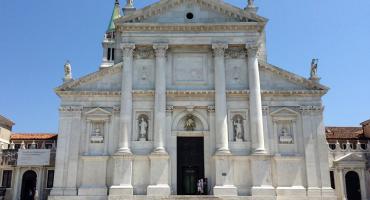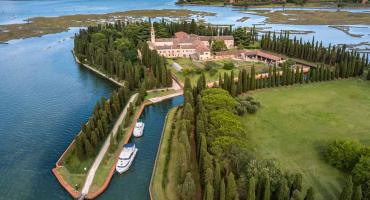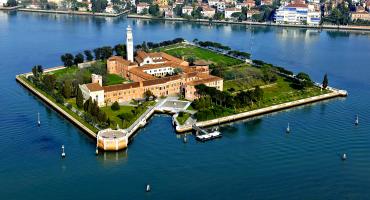As we have seen, the small islands of the lagoon became populated around the year 1000, representing a natural setting for creating the ideal environments of silence and contemplation that monastic orders sought to establish the necessary distance between themselves and worldly matters.
Almost all of the current islands, now largely abandoned, derive their names from ancient settlements and, above all, from the churches or abbeys that were built over time. However, these islands experienced periods of splendor and decline, with a succession of religious orders settling in various periods.
The only island that was always occupied by the Benedictines is the island of S. Giorgio Maggiore. It became an integral part of the city as the surrounding marshy areas were reclaimed and the Piazza, with its architectural arrangement, assumed the role of the city's central place for political, religious, and social functions. S. Giorgio itself seemed to reflect the splendor of S. Marco with its grand architectural works from the 16th and 17th centuries and its acquired artistic riches.
Two other islands have remained and are still occupied by their founding orders: the island of S. Lazzaro degli Armeni, which was not suppressed during the Napoleonic era, and the island of S. Francesco del Deserto, which has always belonged to the Franciscans of various families, although it has also experienced periods of abandonment.
The initial impetus of the Benedictine presence, including the Benedictine nuns, weakened particularly during the 14th and 15th centuries, due to a decline in the influence of monastic orders at the time, sometimes due to less than exemplary behavior. Often, monastic orders that arose after the year 1000, such as the Carthusians, the Augustinians, and the followers of S. Romualdo, took over the abandoned convents.
Their lifestyle requirements were better suited to solitary places, and the new wave of renewal in the 15th century focused more on asceticism. The Benedictine presence was rather concentrated around important and famous communities such as S. Giorgio and, for the nuns, the monasteries of S. Zaccaria and S. Lorenzo.
In the context of a return to an asceticism that harkened back to the origins of the monastic movement, the foundation of the Canons Regular of S. Giorgio in Alga gained great significance. Composed of Venetian nobles who forged an original path to monastic life, they significantly influenced the Church of their time, producing figures such as Pope Eugene IV, Francesco Condulmer, the first Patriarch of Venice, Lorenzo Giustiniani, who was destined for sainthood, and a vigorous reformer like Ludovico Balbo.
From the mid-17th century, a period of more pronounced decline for monastic institutions began: first Pope Alexander VII in 1656 and then Pope Clement IX in 1668 dissolved some minor orders to support Venice in the fight against the Turks in Candia.
The Napoleonic suppressions at the beginning of the 19th century practically marked the end of convent life on the islands. Except for S. Servolo, Le Grazie, and S. Clemente, which, due to their accessibility from the historic center, were used for health purposes until recent years, the predominant use of the smaller islands became military: from gunpowder depots, which often caused irreversible damage, to fortifications mainly created by the Austrians, who feared the unfamiliar environment of the lagoon, to barracks that occupied and destroyed the remaining convents. Even islands like the Old and New Lazzaretto and Poveglia experienced destruction and looting. Of the islands rich in convents and churches seen in old prints, we know only a name and a history.



